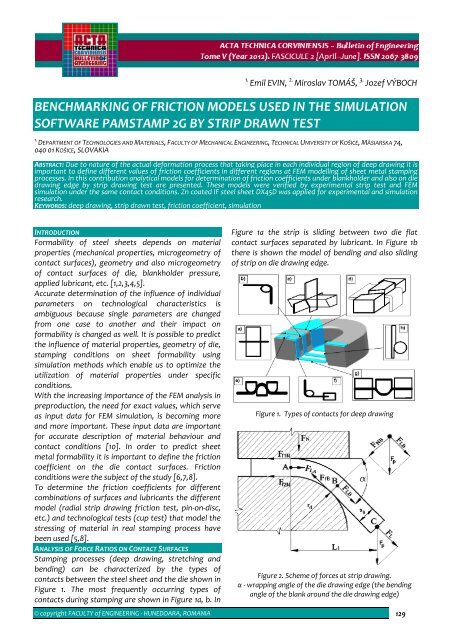Editorial & Advisory Board - Acta Technica Corviniensis
Editorial & Advisory Board - Acta Technica Corviniensis
Editorial & Advisory Board - Acta Technica Corviniensis
You also want an ePaper? Increase the reach of your titles
YUMPU automatically turns print PDFs into web optimized ePapers that Google loves.
1.<br />
Emil EVIN, 2. Miroslav TOMÁŠ, 3. Jozef VÝBOCH<br />
BENCHMARKING OF FRICTION MODELS USED IN THE SIMULATION<br />
SOFTWARE PAMSTAMP 2G BY STRIP DRAWN TEST<br />
1.<br />
DEPARTMENT OF TECHNOLOGIES AND MATERIALS, FACULTY OF MECHANICAL ENGINEERING, TECHNICAL UNIVERSITY OF KOŠICE, MÄSIARSKA 74,<br />
040 01 KOŠICE, SLOVAKIA<br />
ABSTRACT: Due to nature of the actual deformation process that taking place in each individual region of deep drawing it is<br />
important to define different values of friction coefficients in different regions at FEM modelling of sheet metal stamping<br />
processes. In this contribution analytical models for determination of friction coefficients under blankholder and also on die<br />
drawing edge by strip drawing test are presented. These models were verified by experimental strip test and FEM<br />
simulation under the same contact conditions. Zn coated IF steel sheet DX45D was applied for experimental and simulation<br />
research.<br />
KEYWORDS: deep drawing, strip drawn test, friction coefficient, simulation<br />
INTRODUCTION<br />
Formability of steel sheets depends on material<br />
properties (mechanical properties, microgeometry of<br />
contact surfaces), geometry and also microgeometry<br />
of contact surfaces of die, blankholder pressure,<br />
applied lubricant, etc. [1,2,3,4,5].<br />
Accurate determination of the influence of individual<br />
parameters on technological characteristics is<br />
ambiguous because single parameters are changed<br />
from one case to another and their impact on<br />
formability is changed as well. It is possible to predict<br />
the influence of material properties, geometry of die,<br />
stamping conditions on sheet formability using<br />
simulation methods which enable us to optimize the<br />
utilization of material properties under specific<br />
conditions.<br />
With the increasing importance of the FEM analysis in<br />
preproduction, the need for exact values, which serve<br />
as input data for FEM simulation, is becoming more<br />
and more important. These input data are important<br />
for accurate description of material behaviour and<br />
contact conditions [10]. In order to predict sheet<br />
metal formability it is important to define the friction<br />
coefficient on the die contact surfaces. Friction<br />
conditions were the subject of the study [6,7,8].<br />
To determine the friction coefficients for different<br />
combinations of surfaces and lubricants the different<br />
model (radial strip drawing friction test, pin‐on‐disc,<br />
etc.) and technological tests (cup test) that model the<br />
stressing of material in real stamping process have<br />
been used [5,8].<br />
ANALYSIS OF FORCE RATIOS ON CONTACT SURFACES<br />
Stamping processes (deep drawing, stretching and<br />
bending) can be characterized by the types of<br />
contacts between the steel sheet and the die shown in<br />
Figure 1. The most frequently occurring types of<br />
contacts during stamping are shown in Figure 1a, b. In<br />
Figure 1a the strip is sliding between two die flat<br />
contact surfaces separated by lubricant. In Figure 1b<br />
there is shown the model of bending and also sliding<br />
of strip on die drawing edge.<br />
Figure 1. Types of contacts for deep drawing<br />
Figure 2. Scheme of forces at strip drawing.<br />
α ‐ wrapping angle of the die drawing edge (the bending<br />
angle of the blank around the die drawing edge)<br />
© copyright FACULTY of ENGINEERING ‐ HUNEDOARA, ROMANIA 129

















